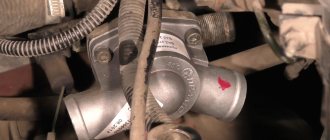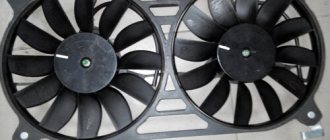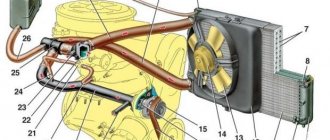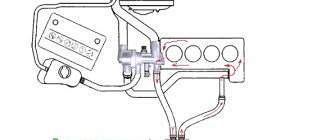Let's check the functionality of the thermostat of the carburetor engine cooling system of VAZ 2105, 2107, 2108, 2109, 21099 cars. To check the thermostat and evaluate the correctness of its operation, you need to know its role in the car's cooling system and the principle of operation.
The thermostat separates two circles of the cooling system (small and large) and has two valves: bypass and main. While the engine is warming up, coolant circulates through the small circle and the open thermostat bypass valve. The thermostat prevents it from mixing with the liquid from the large circle and thereby helps the engine warm up quickly. Therefore, the simplest way to check the functionality of the thermostat is by touch, directly on the car. When operating correctly, its upper part warms up first, and then the lower part.
The procedure for checking the thermostat on VAZ 2108, 2109, 21099 cars without removing it from the engine
When the engine warms up, circulation occurs in a small circle. Warms up: cylinder block, cylinder head, carburetor heating block, stove, upper part of the thermostat. We check the heating of the thermostat with our hands: its upper part should be warm, and after a few minutes it becomes hot. The bottom of the thermostat remains cold. In addition, the lower hose to the radiator will also be cold, and the upper one will be slightly heated.
After some time, the lower part of the thermostat and the lower radiator hose suddenly become hot - this opens the main thermostat valve. Circulation went through the radiator (large circle).
The procedure for checking the thermostat on VAZ 2105, 2107 cars without removing it from the engine
The check is similar to the check on VAZ 2108, 2109, 21099, only when circulating in a small circle, the following elements of the cooling system warm up: the cylinder head tee, the upper hose to the radiator, the upper radiator tank, the heater. The lower part of the radiator and its lower hose remain cold. After the thermostat operates at a temperature of 80-85º (the coolant temperature gauge needle is 3-4 mm from the red zone), the lower part of the thermostat and the lower radiator tank warm up.
Checking the removed thermostat
You can check the removed thermostat of VAZ 2105, 2107, 2108, 2109, 21099 cars. To do this, immerse it in a container with hot water (preheating temperature 73-75º). We heat the water further, stirring it, and observe the movement of the main thermostat valve. When the valve begins to open (approximately 1 mm), the temperature of the liquid should be measured. If the thermostat is working, it will be 81±5º for VAZ 2105, 2107 and 87±2º for VAZ 2108, 2109, 21099. A faulty thermostat should be replaced.
Notes and additions
— The stroke of the main thermostat valve at 102º for VAZ 2108, 2109, 21099 is about 8 mm. For VAZ 2105, 2107 at 94º from 6 to 8 mm.
More articles on VAZ car engines
If the thermostat fails, the engine will take a very long time to heat up to the required operating temperature, and while driving, the engine temperature will drop sharply. This is especially felt in winter due to a poorly heating stove.
Appearance of the device
Check and replacement
If the thermostat fails, it should be replaced immediately. It is impossible to say that the device has failed only on the basis of an initial check.
If the engine overheats during operation or does not warm up to operating temperatures quickly enough, the condition of the unit is checked. Based on the results obtained, replacement or repair is carried out.
The most effective way to check the thermostat is to remove it. The procedure is performed as follows:
- Unscrew the crankcase protection mounting bolts, after which the protection must be removed and placed aside for a while.
- Remove the cap from the expansion tank where the coolant is located.
- Place a clean container under the drain hole (if you plan to pour the same coolant back into the system), unscrew the drain plug from the cylinder block and remove all coolant from the cylinder block.
- Place a container under the drain hole of the cooling radiator, unscrew the plug and drain the antifreeze or antifreeze.
- Loosen the clamps holding the hoses.
- Disconnect the three hoses that are connected to your thermostat housing.
- Loosen the tension on the clamps and remove the thermostat along with the hose. The short hose is disconnected from the thermostat.
- Place the dismantled device in a container of water, which must be preheated to 78-80 degrees Celsius.
- Start heating the water, stirring the liquid occasionally. The water needs to be heated to approximately 87 degrees Celsius.
- If the thermostat is working properly, when the temperature reaches 87 degrees with an error of plus or minus 2 degrees, the main valve should open. If this does not happen, the device is faulty and requires replacement.
Scheme and design
In order to promptly determine the malfunction, check or replace the thermostat, you must first understand its circuit and design elements.
The scheme presented above is deciphered as follows.
| Item number | What is this? |
| 1. | Inlet pipe coming from the radiator |
| 2. | Rubber insert |
| 3. | Heat sensitive solid filler |
| 4. | Bypass valve spring |
| 5. | Inlet pipe coming from the engine |
| 6. | Bypass valve |
| 7. | Outlet pipe going to the pump |
| 8. | Main valve spring |
| 9. | Main valve |
| 10. | Pipe coming from the expansion tank |
| 11. | Piston |
Self-replacement of the VAZ-2109 thermostat
How to check and replace the VAZ-2109 thermostat (8 or 16 valves)? This procedure is not very complicated, and even a less experienced car owner can handle it without much difficulty. What needs to be done is described in this article.
The thermostat itself is a mechanical device whose operation is based on purely physical principles. Inside it is wax that is sensitive to temperature changes. When the coolant heats up, the substance melts and, as a result, the damper opens, allowing it to enter the cooling system.
From the VAZ-2109 to the relatively new Granta, thermostats work exactly the same, and moreover, they are interchangeable. True, the new units are somewhat shorter than the old ones, but this in no way prevents them from being installed.
Often, from the above-mentioned more modern model, a thermostat is installed if the stove does not “fry” too much.
Car thermostat price
This device is, indeed, not an expensive part, and its cost depends on the brand of your car. The price of a thermostat for VAZ 2101, 2108, 2110 and 2121 is approximately 230 rubles. A thermostat in a housing will cost approximately 400–550 rubles or more, but for a Lada Granta 8V car you can buy it for 1,200 rubles. For foreign cars - on average from 550 to several thousand rubles. The most common, popular and high-quality thermostats are GATES and WAHLER brands. There are also positive reviews about the manufacturer Vernet.
How is the check carried out?
First of all, it is worth pointing out that on a VAZ-2109 (with an 8-valve engine, as well as a 16-valve engine) you do not need to drain the coolant to check. The procedure is:
- start the engine;
- check the temperature of the lower pipe leaving the radiator.
Normally, it should remain cold, since the liquid circulates only in a small circuit. It heats up gradually. As the coolant reaches a temperature ranging from 87 to 92 degrees and the wax in the thermostat melts, the damper opens and a large circle begins to operate. If this does not happen, then the thermostat will have to be changed.
Before buying a new one, check whether the old one is really damaged. This is not difficult to do, just put the device in a pan of water (on a rag) and heat it to 87-90 degrees. A working device will open the main valve.
If it becomes necessary to remove the thermostat, then it will not be possible to do without draining the coolant. Some craftsmen claim that they were able to avoid the above procedure, but in reality it turns out that this option requires much more labor and still leads to the loss of 3 out of 5 liters of liquid. Therefore, it is better not to suffer and do everything as it should be. To do this, unscrew the plug located at the bottom of the radiator and drain the coolant into a suitable container. Then:
- remove the air filter;
- loosen the clamps holding the hoses;
- disconnect the mass from the thermostat;
- Unscrew the nut and pin holding the device.
How to check the thermostat without removing it from the car
The thermostat is a key component of the cooling system, which is responsible for high-quality warming up of the engine by timely redirecting coolant flows in a small or large circle. Failure of this component inevitably leads to a number of problems - overheating of the engine or the inability of it to reach the desired temperature.
That's why a car enthusiast needs to know how to check the thermostat and what malfunctions of this device exist.
Common reasons for device failure
During the operation of the car, the following thermostat breakdowns and the reasons for their occurrence are possible.
1. Increased heating time of the power unit.
The motor operates unstably (for example, it trips), which leads to excessive fluctuations of the thermostat valve and damage to its seat. Due to exposure to strong vibration, damage to the temperature-sensitive element occurs.
The result is that coolant gets inside the unit (wax comes out), which leads to a malfunction of the device, which stops opening or closing the valve when the required temperature level is reached.
2. The valve of the device opens ahead of time. The cause of such a breakdown may be the ingress of coolant into a special element that controls the temperature level of antifreeze in the system.
The result is an increase in the total volume of the filler and premature opening of the valve.
3. The thermostat opens with a delay.
The reason is the appearance of a leak of a special filler that allows the device to respond to temperature changes.
Changing the volume of this element downwards will require more heating to open the valve.
The result is that the thermostat operates with a certain time delay.
4. The engine regularly overheats.
For example, situations are possible when the thermostat allows coolant to pass through on time, but the engine still reaches a high temperature.
The reason is that the fluid is not passing through the main radiator, but is being discharged through the return line back into the engine.
5. The thermostat valve is not fully open due to mechanical damage.
The result is a small volume of liquid entering the radiator to completely reduce the temperature in the system.
6. The valve is not fully closed.
This is possible when coolant “sneaks” into the working element.
Due to the increase in the volume of the working element, the valve disc cannot close completely.
7. Incorrect operation of the device.
For example, opening and closing it ahead of time. This is possible in case of failures in the factory settings and excessive overheating of the cooling system of the power unit.
8. Destruction of the rubber seal.
Due to a breakdown, oil gets into the coolant. The latter acts as a solvent for the rubber valve seal (rubber simply cannot withstand the impact).
3
Ways to solve problems Possible solutions to the problem include:
1. If the coolant temperature exceeds the norm (provided the thermostat is working and it is correctly selected), it is necessary to replace the device, but with a higher opening temperature. As a rule, this step is recommended for motorists who operate cars in the mountains and in regions with high average annual temperatures.
2. When opening the thermostat late, it is important to ensure that there are no plugs and that the system is completely filled. If the problem is caused by a plug (coolant stagnation), then the best solution is to make a small hole in the plate (2-3 mm). As a result, the coolant flow near the thermostat is normalized, and the engine warm-up time increases.
3. Early opening of the thermostat is possible due to excessive pressure in the system. Zones of different pressure often appear around the device, which leads to early operation of the valve.
There are several reasons:
- failure of the cooling system;
- The thermostat spring has weakened;
- The engine runs at higher speeds during the warm-up period.
4. The engine takes too long to warm up.
Causes:
- incomplete closing of the thermostat valve;
- violation of the integrity of the valve plate (for example, a gap has appeared);
- Incorrect thermostat position (possibly changing the location of the air valve).
5. The engine heats up above normal even in a situation where the thermostat is fully open:
- traffic jams or low coolant level;
- failure of the radiator (clogging of its cells);
- failure of the cooling pump or fan;
- contamination of the cooling system.
How the thermostat works in a car
Brass and copper are the main components from which these devices are made. And the basic principle of operation of a car thermostat is hidden by a small cylinder that can be seen from the engine side. The cylinder contains a small wax ball, although not made from real wax; the melting point of the material from which it is made is 82 degrees Celsius. Wax was not chosen as a material for this element by chance; it has the property of increasing in volume under the influence of temperature, that is, making transitions from solid to liquid. When the wax melts and expands, it will create pressure that will cause the pin to fall out of the cylinder and open the valve through which coolant enters the radiator. And when the engine temperature returns to normal, the wax hardens again, taking its previous position and shape.
There are many factors that can cause problems, but corrosion is the most common. When the valve is constantly in the open position, engine cooling fluid will always flow into the radiator before entering the engine, which means the engine needs more time to reach critical temperature. And when the thermostat valve is constantly closed, the engine does not cool down and continues to gain temperature, accordingly, the car “boils” and you cannot continue driving it until the engine cools down. Experts and auto mechanics recommend that motorists replace the old one with a new one approximately every two years. Read how to change the thermostat in a VAZ 2110-2111 car.
Thermostat diagram VAZ 2107, 2114, 2115
How to correctly determine that the device is in working condition?
We warm up the engine to such a temperature that the needle does not reach the critical value, and turn it off. We open the hood, find a hose on top of the radiator (a black rubber hose with a metal clamp at the end) and the same one on the bottom. Then, very carefully, they may be quite hot, touch them. If one of them becomes hot, and the other is still cold, and the sensor shows a high engine temperature, this means that most likely the liquid does not enter the engine, but is retained in the radiator, and you need to change the thermostat to a new one.
There is another way of checking, better known as “folk”. It echoes the “experiment” that was described above, to observe the process of the thermostat, only this time you will have to put the thermostat, the functionality of which you doubt, removed from your car, into a container with water, and then the procedure is repeated as Once the water reaches a temperature of 87–90 degrees, the valve should open, however, if this does not happen, then the thermostat is no longer suitable for operation. It is also worth remembering that different thermostats may have different critical valve opening temperatures, so when purchasing a new one, check this with the seller. Since it is no secret to the driver that it is impossible to install a thermostat in a car that has a high valve opening temperature - the engine will not cool.
Installing a New Thermostat
Before installing a working device, it is necessary to clean its location from dirt and rust. Apply a thin, even layer of any neutral sealant to the degreased surface. You should wait at least 10 minutes for it to dry slightly. After this, a new node is installed.
In the end, all that remains is to pour the required amount of coolant into the system, making sure that no air pockets form.
To make sure that everything is functioning normally, you need to start the power plant and inspect all connections for leaks. If detected, the latter are eliminated by tightening the fastening clamps.
In the vast majority of cases, after replacing the old thermostat, all unpleasant symptoms disappear for a long time.
The video below shows the replacement process in detail:
Reasons to install a thermostat from “ten”
The 6-hole unit has been modified, when compared with the device installed in the “nine”, its advantages over the 5-hole version from 2109 are as follows:
- The device from the “ten” is 5 cm shorter than the standard version of the “nine”, so there will be more space under the hood.
- A more modern 6-hole thermostat works more stably, as a result, the temperature remains unchanged.
- In the event of a breakdown, you do not have to change the entire device, since it is dismountable, and if necessary, you can only change the thermoelement.
- When servicing, you won’t have to struggle with a large number of clamps, since the 6-hole version is secured with a rubber tube.
- It should be noted that until 2003, VAZ 2110s were also equipped with a device with five holes, so you need to buy a version from later releases.
Thermostat VAZ 2110 (injector) 8 valves for VAZ 2109
Many owners of the VAZ 2109 do not like the original thermostat, because because of it they have to freeze in the winter until the car warms up to the same 60 degrees. This problem can be solved by installing a VAZ 2110 thermostat (injector) 8 valves. This is a more advanced thermostat and it has a number of advantages over the original one from the VAZ 2109.
The thermostat on the VAZ 2110, installed on an 8-valve injection engine, is made collapsible. Now, if the thermostat breaks down, you don’t need to change the whole thing, but you can disassemble it and simply replace the thermocouple.
The new thermostat is also 5 cm shorter than the original one, which increases the space.
There are fewer clamps for fastening on the thermostat of the 8-valve injection engine from the VAZ 2110. The thermostat was also modified so that it maintains a stable temperature in the cooling system.
We connect the thermostat from the VAZ 2110
First of all, you need to remove the old thermostat; to do this, first disconnect the pipe from the throttle body and drain a certain amount of antifreeze. After this, you will need to carefully disconnect the return pipe to the heater radiator without spilling the coolant.
The new thermostat of the VAZ 2110 8-valve injection engine is connected according to the diagram; during installation, you will need to add a new pipe, a “saxophone,” through which the antifreeze will be directed back to the pump.
The peculiarity of using the new thermostat from the VAZ 2110 is that now, when starting a cold engine, the coolant moves in a small circle. So, the heater radiator heats up first, which allows you to quickly heat the interior. When the temperature reaches a certain value, the thermostat opens and the coolant begins to circulate in a large circle, already through the main radiator.
Why an 8-valve injector?
To replace the thermostat on a VAZ 2109, only a thermostat from the 8-valve injection engine of the VAZ 2110 is suitable. If you take a replacement thermostat for a 16-valve engine, it will not work, since it has a different coolant circulation system.
The purpose of the thermostat, its location and malfunctions
In modern cars, including the “nine”, the power plant is cooled using liquid (antifreeze, antifreeze). To regulate the temperature of the antifreeze, a thermostat is installed between the radiator and the VAZ 2109 engine. The main functions of this unit are maintaining the desired thermal conditions and warming up the power plant of the VAZ 2109. This is a small cylinder with a valve, which is located under the hood near the cylinder blocks. It is quite easy to find as there are several hoses included in the housing.
Advice! To check whether the device is working or not, you should warm up the VAZ 2109 engine so that the temperature arrow does not reach the limit. After this, you need to turn off the unit, lift the hood and find under it the upper and lower hoses extending from the radiator (about 5 centimeters in diameter, black rubber). You need to carefully touch the hoses; if the lower one is cold and the upper one is hot, then most likely the thermostat is jammed.
There are two main malfunctions: the valve is stuck in a fully or partially open position, the valve is stuck in a fully closed position. In the first case, the engine will take a long time to warm up to normal temperature, and in cold periods the engine may not warm up at all. If the valve does not open completely, then the operating temperature of the power plant will not be higher than 70 degrees. When the valve is stuck in the closed position, the motor can overheat in any operating mode.
Signs of breakdown
What could be the first sign that the VAZ-2109 thermostat is faulty? Of course, the engine overheats even when driving at a high constant speed. The reason is that the liquid continues to circulate in a small circle, not a drop gets into the radiator. And even turning on the electric fan won’t help, because doing so is simply useless. The only thing that can slightly correct the situation is opening the heater tap and turning on the interior airflow at maximum speed.
But such an action will not bring comfort in hot weather. The most common thermostat breakdown is the sensing element jamming in its original position (the liquid moves in a small circle). If this suddenly happens, then you need to try all methods of elimination. Even a few light blows to the body can open the valve. If such an emergency occurs on the road, you will have to drain the liquid and break all the insides of the thermostat so that the liquid circulates only in a large circle. But it won’t boil, and you can get to the repair site.
Is it worth the bother?
Thermostat 21082 is a one-piece design, securely attached to the cylinder head. Fewer connections on clamps, no intermediate hoses - less chance of leaks.
In the future, replacing the thermoelement will require less manipulation - unscrew 3 bolts and disconnect 2 hoses. You can even get by by disconnecting one hose if you get creative. Replacing the thermoelement becomes much more convenient.
Another advantage is the reduced diameter of the bypass hole, which (as they say) affects the engine warm-up speed and increased flow through the heater, although logically the increase in flow is unlikely to be significant.
Well, the size of the thermostat frees up space in the area above the gearbox.
In addition, in the circuit with thermostat 21082, the expansion tank is included in a small circle, and not in a large one as in circuit 2108.
Preparing for replacement
In order for the car to be completely ready to replace the thermostat, you need to wait until the engine cools down to at least 40-50 degrees. It is extremely dangerous to work while it is hot; you can get burned. The thermostat on a VAZ-2109 is replaced quite quickly; the most difficult and tedious procedure is emptying the system. To do this, you need to use two drain holes, which are located in the lower part of the radiator (the plug is unscrewed by hand) and in the engine block (head bolt 13).
But what should you do if the system is filled with antifreeze, which is quite expensive? We must try to preserve it so that it is not expensive to repair the car. To do this, first of all, by opening the stove tap, unscrew the clamp on the pipe that goes to the throttle valve. It is necessary to drain the maximum possible amount of antifreeze through it. Yes, this procedure is slow, but it will save almost all the liquid. Only after this can you unscrew the plug on the radiator and on the engine block. And don’t forget to unscrew the cap on the expansion tank to increase the pressure.
Refilling the cooling system
It will take you a few minutes to add fluid and bleed the cooling system. First of all, check that all pipes are securely installed and that all clamps are tightened. Then look to see if the engine block and radiator plugs are in place. If not, then install them. Now you can open the stove tap and pour liquid into the expansion tank. The gurgling stopped - they closed the plug and started the engine. Wait until it warms up to operating temperature - about 90 degrees. If necessary, add fluid to the reservoir. It is necessary that its level is between the lower and upper marks.
see also
“Peter - AT” INN 780703320484 OGRNIP 313784720500453
What is a VAZ-2109 thermostat, when is it necessary to replace it, what are the main signs of failure, we will tell you in this article. Our publication also contains a detailed description of how to install a more advanced thermostat from a model 2110 car. Its advantages will be discussed a little below. And it’s worth starting with theory; you need to understand what kind of device the thermostat has, what functions it performs in the cooling system of an internal combustion engine.
How to quickly determine that the thermostat on a Priora is faulty?
1. Warm up the engine slightly (to about 85 degrees).
2. Open the hood. Carefully touch the radiator hose at the bottom. A cold pipe indicates that the thermostat is working properly. The liquid does not flow to the radiator at this temperature, since the Priora’s thermostat is still closed. If the pipe is hot already at 80 degrees, this indicates a malfunction.
Symptoms of malfunction
The following indicates that the thermostat is not working properly:
- the long period required for the motor to reach operating temperature;
- rapid overheating of the power plant;
- high coolant temperature.
It is the systemic excess of temperature standards that, as a rule, leads to breakdown of the entire engine. For this reason, it is necessary to replace it at the first sign of a thermostat malfunction.











